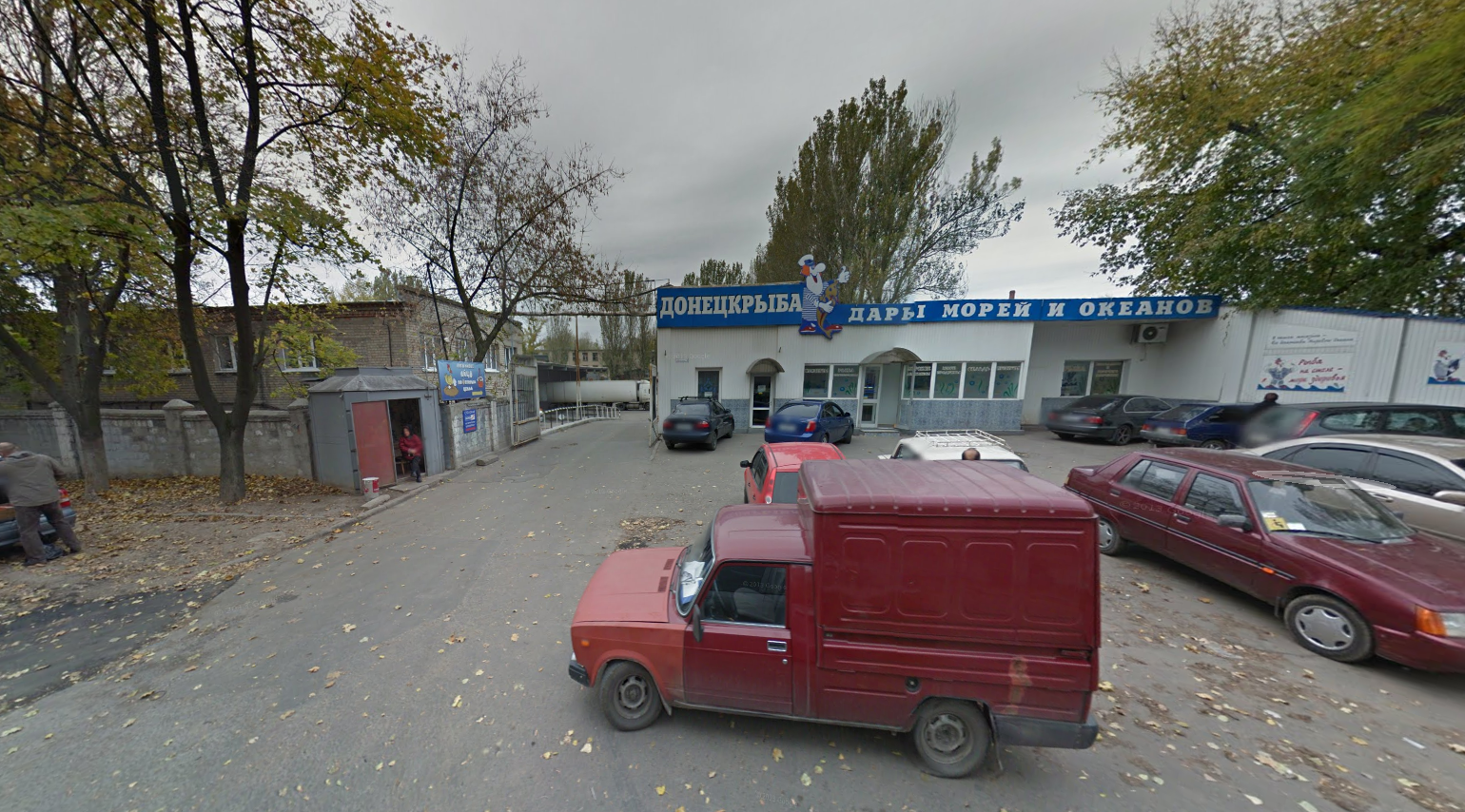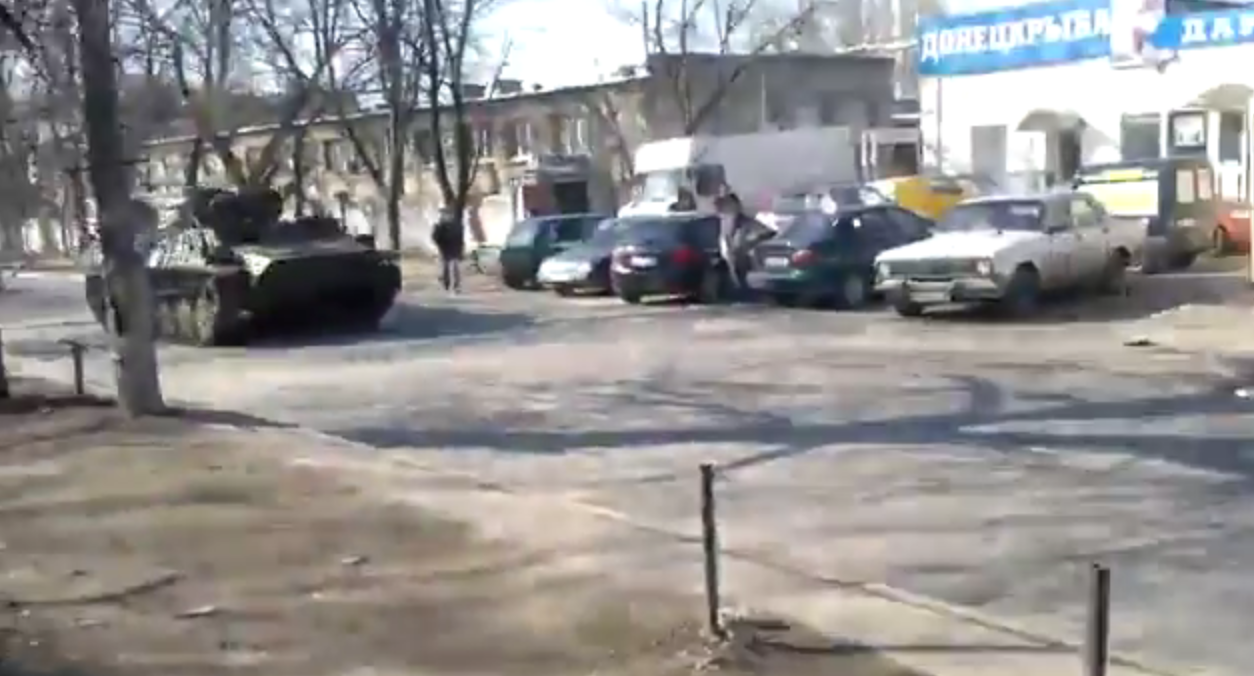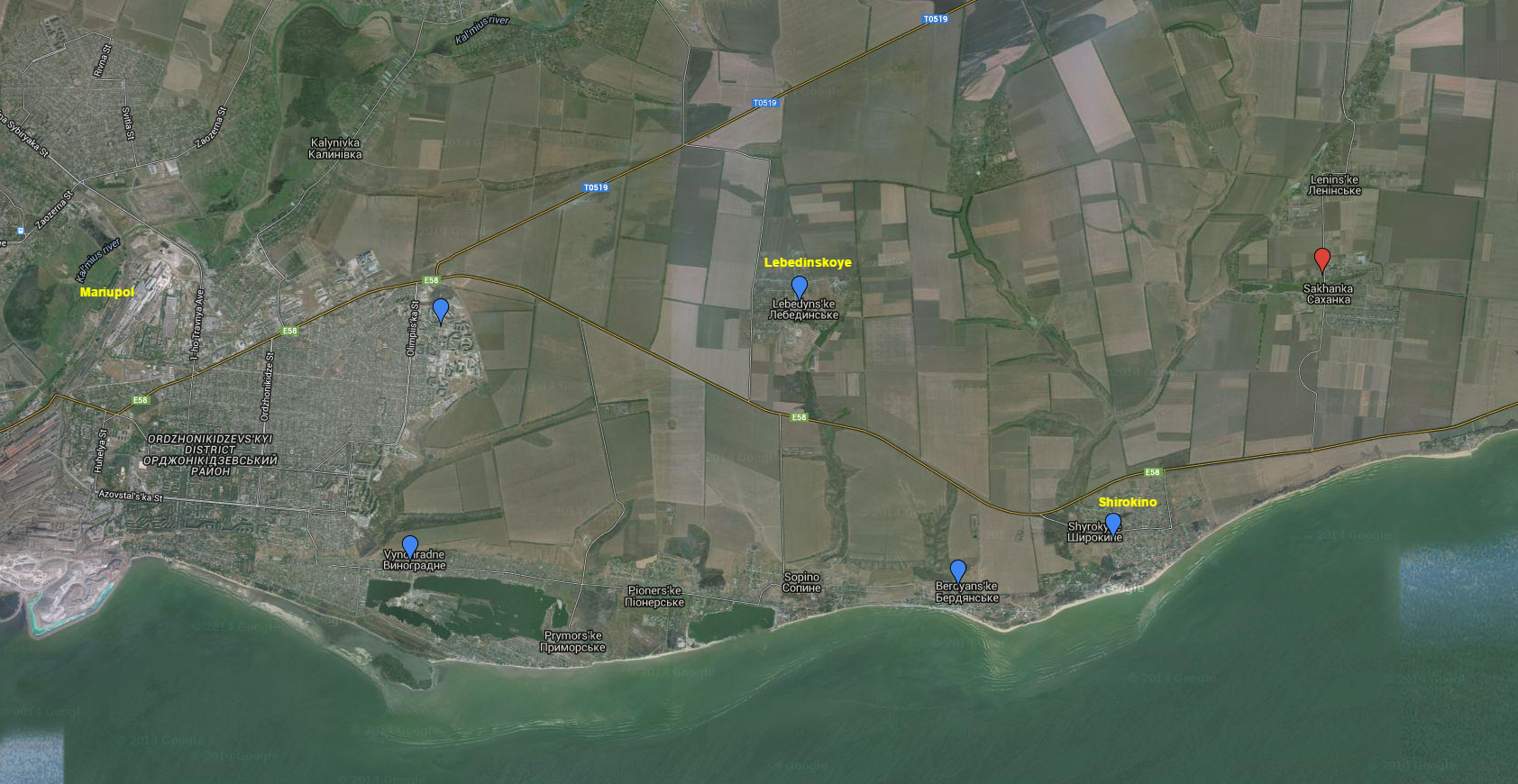Yesterday’s live coverage of the Ukraine conflict can be found here. An archive of our liveblogs can be found here. For an overview and analysis of this developing story see our latest podcast.
Please help The Interpreter to continue providing this valuable information service by making a donation towards our costs.
For links to individual updates click on the timestamps.
For the latest summary of evidence surrounding the shooting down of flight MH17 see our separate article: Evidence Review: Who Shot Down MH17?
The Ukrainian military spokesperson, Andriy Lysenko, says that the Russian-backed separatists are not withdrawing, but rather repositioning, their heavy artillery. Kyiv Post reports:
“Militants only imitate the withdrawal of heavy artillery,” Lysenko told reporters at a daily briefing on March 10. “They use the cease-fire regime to reinforce their units, getting more of engineering and military equipment, manpower and ammunition.”
Pulling heavy artillery back is one of the points of the Minsk peace agreement signed on Feb. 12. But although there have been signs of movement, there is doubt that the gear is actually being pulled away as agreed.
NATO supreme allied commander in Europe General Philip Breedlove said on March 8 that heavy artillery is being moved on both sides of the contact line.
“But we do not know what’s happening to the artillery on the east side of contact, because the OSCE (Organization for Security and Cooperation in Europe) observers have not been allowed to go and observe that they are breaking down, that they are moving and where are they moving to,” he said. “We see them moving, but we don’t know if they are returning or simply repositioning for the next engagement.”
Ukrainian blogger and military expert Dmytro Tymchuk is warning that Russian-backed militants continue to stage near Mariupol, in the area where fighting has been reported today. UNIAN reports:
“The group consists of 2,500 people, divided into several tactical groups of mixed composition (local rebels and Russian mercenaries), having at its disposal 25 tanks and 18-20 armored fighting vehicles, up to 60 units of army vehicles, more than 20 MT-LB and other tractors, and all sorts of converted all-terrain vehicles (primarily operated by mobile mortar teams),” Tymchuk wrote.
He also said that the strike group of the militants near Mariupol has been reinforced by military equipment and manpower coming from the north through Telmanovo, and directly across the border from Russia in the area of Maksymovo (with reports that 10-12 armored vehicles pass through Novoazovsk and Bezimenne every day).
“This strike group is being supported by an artillery group, which has 14 multiple rocket launcher units and around 32-36 artillery guns and self-propelled artillery cannons, as well as a large number of mortars. The artillery group primarily operates in separate firing units, but is managed from a single command center,” Tymchuk said.
Meanwhile, the United States is reporting that Russia has sent more weapons to eastern Ukraine just in the last few days. RFE/RL reports:
“We can confirm new transfers of Russian tanks, armored vehicles, heavy artillery, and rocket equipment over the border to the separatists in eastern Ukraine,” said Assistant Secretary of State for European Affairs Victoria Nuland at a U.S. Senate Foreign Relations Committee hearing on March 10.
Moscow has continually denied sending weapons and troops to the pro-Russian separatists.
Nuland said that the United States had begun initial conversations with European allies on more sanctions should Russia fail to implement the cease-fire or take more land.
Ukraine’s President Petro Poroshenko has taken a somewhat softer tone on the issue, however. The Guardian reports:
“There is a ceasefire, or there isn’t. It depends on how you look at it, Poroshenko said in a televised interview. “We can say that we managed to halt the offensive drive of the aggressor.”
“Ukraine has withdrawn the lion’s share of its rocket and heavy artillery systems. The Russian-backed fighters have also withdrawn a significant amount.”
While the Minsk agreements have been broadly observed along the frontlines in the past two weeks, Kiev has accused the rebels of continuing to fire on government positions and using the truce to regroup and rearm for a further offensive, a charge the rebels deny.
Poroshenko said 64 Ukrainian servicemen had been killed since the ceasefire was meant to come into force on 15 February. Nearly 6,000 people have been killed since the conflict between government troops and separatists erupted last April, the UN estimates.
— James Miller
Graham Phillips, a British freelance video journalist who has been operating for most of the last year in eastern Ukraine, and produces propaganda videos for Russian state-owned media including RT and the Ministry of Defence-owned Zvezda channel, is now back in London.
Phillips has now announced, with fanfare from the Russian, state-owned Sputnik news agency, that he will hold a fundraising event “for Donbass” on March 30 in Whitehall, London.
The money would, he said, go to both a hospital in Donetsk and “the city of Pervomaisk,” though the actual recipients in the latter case are unclear.
Phillips wrote on his Facebook page that the event would consist of a talk and an auction of his photos and memorabilia from the conflict
You may remember Phillips from various reports on our blog, such as when he inadvertently revealed the presence of Russian T-72B3 tanks near Debaltsevo, a fact he subsequently attempted to deny. Or when he claimed to have been shot at by Ukrainian soldiers when he set off a trip-flare in a field.
But Phillips’ most serious transgressions of the line between journalist and propagandist are exemplified by these videos from September last year, of Phillips “interviewing” Ukrainian POWs.
In the following video, Phillips repeatedly demands of the prisoners that they explain why they have come to kill civilians. Furthermore he asks them if they are:
“ready to go home now and accept that it is Novorossiya here and not Ukraine?”
This is clearly pushing a propaganda line and is completely at-odds with journalistic ethics with regards to POWs.
In another, deeply troublesome video, Phillips “interviews” a severely burnt man who is purportedly a captured member of the Ukrainian Aidar volunteer battalion.
Again, Phillips asks him to justify his presence in the conflict and asks leading questions about ‘Novorossiya’ and the sham referendum conducted last summer.

Phillips’ event is to be held at Walkers of Whitehall, a pub just off Trafalgar Square. A post from Phillips thanked one Steven Lacey for his assistance in organising the event.

Lacey is a convert to Russian Orthodox Christianity and ran for election as a Tory councillor last year in Hounslow, London.

He is also a member of the Westminster Russia Forum (WRF), a successor group to Conservative Friends of Russia (CFR), a lobby group that was quietly re-branded after negative publicity following investigations by The Guardian‘s Luke Harding and The Interpreter‘s Michael Weiss.
Back then, in the spring of 2013, investigations suggested that CFR was functioning as a Kremlin lobby group, run under the influence of the Russian embassy in London. Diplomat Sergei Nalobin was extensively involved in the group, appearing at numerous events and arranging trips and meetings.
Since the re-brand, Nalobin continued to be a regular at WRF meetings. The WRF has hosted several influential British politicians, including the former foreign secretary, Jack Straw, who, along with former CFR honorary president, Sir Malcolm Rifkind, was subsequently been revealed to be offering influence for money.
Phillips’ event is not officially connected to WRF, but Lacey’s involvement suggests ties between this pro-Kremlin group and the British pro-separatist star.
Furthermore, a comparison of the photo of Phillips and Lacey with this one, taken at a WRF talk by Sir Tony Brenton, former UK ambassador to Russia and member of the board of directors at the Russo-British Chamber of Commerce, suggests Phillips was at the WRF meeting and then photographed at the nearby Walkers of Whitehall, a venue often used by WRF, with Lacey:
While the re-branding of CFR was supposed to represent a shift from Tory-aligned to non-party-political, a move also testified to by the invitation of Labour’s Straw, the majority of members I spoke to at a WRF event in 2013 still insisted that the group was for Conservative supporters. Phillips has recently announced a change of allegiance, joining the nationalist, pro-Russian UK Independence Party (UKIP).
It will certainly be interesting to see what other connections emerge between Phillips’ event, the WRF, and the wider pro-Kremlin lobbying scene in London.
— Pierre Vaux
The accuracy of the geolocation can easily be verified by comparing the view from Google Streetview linked above with two screenshots from the video:



This means that the Strelas are headed north on Sechenova street, east of the city centre.


As The Interpreter‘s James Miller and Catherine A. Fitzpatrick wrote on February 3, Strela-10 units appear to enter Ukrainian alongside larger convoys of Russian armour:
There is evidence that both the Strela-10 and the Buk appeared in Ukraine alongside significant convoys of Russian armor and weapons, indicating that these weapons were potentially sent by the Russian military to protect the new hardware that was entering the conflict. A significant piece of evidence supporting this theory came to light in late August, at the height of the “Russian invasion,” as a very large and powerful military convoy was geolocated headed toward Lugansk. In that convoy were, among many other pieces of heavy equipment, four T-72 battle tanks and one Strela-10. This was perhaps the first infusion of T-72s into this battle, so at the time this convoy was considered indisputable proof that the Russian military was attacking the Ukrainian military.
Furthermore, there are no reports of such systems being lost by the Ukrainian army.
The most recent sightings of Strela-10s were outside Debaltsevo on February 9 and 18 – the day Ukrainian troops were evacuated.

We now have testimony from Dorzhi Batomunkuev, a Russian soldier who was severely wounded in fighting near Debaltsevo, who reported that Russian army units were extensively involved in the operation to encircle and capture the town. Batomunkuev’s own unit, the 5th tank brigade from Ulan-Ude, entered Ukraine on February 8 and joined Russian forces in Donetsk.
— Pierre Vaux
U.S. President Barack Obama was talked out of sending lethal aid to Ukraine last month by German Chancellor Angela Merkel, according to the German ambassador to the U.S.
AP reports:
The German ambassador to the U.S., Peter Wittig, said in an Associated Press interview that Obama agreed to hold off during a White House meeting in February with German Chancellor Angela Merkel. He said Obama had concurred with Merkel that it was important “to give some space for those diplomatic, political efforts that were underway.”
“The two leaders exchanged views on that issue and there was unity by them not to impose, or not to go forward with, the delivery of lethal defensive weapons at this time,” Wittig told the AP.
The Obama administration has maintained publicly that it’s still debating whether to send anti-tank weapons and other defensive arms to bolster Kiev’s ability to defend its territory and troops in eastern Ukraine. In remarks to reporters after his meeting with Merkel, Obama said that “the possibility of lethal defensive weapons is one of those options that’s being examined” but added that “a decision has not yet been made.”
Last month we guessed that this was the dynamic between the two leaders. Obama was openly saying that he was considering arming Ukraine, he was also suggesting that it was a good idea, all the while a nervous Merkel continued to stress that the intercontinental alliance was the key to fixing this crisis and Europe and the United States needed to stand together.
But there is a deeper problem — both NATO and the European Union’s sanctions regime are threatened by the divisions between those EU countries which want rapprochement with Russia and those who see Russia’s aggression as an existential threat. NATO and the European Union are both organizations that rely heavily on consensus. Since Italy, France, and Germany are three countries which belong to both the EU and NATO and would like to forget that the Ukraine crisis exists, and since Greece has now elected an openly pro-Russian government, it’s not clear that the EU’s sanctions against Russia will be renewed or whether NATO will implement its strategy to strengthen its deterrent factor in Eastern Europe.
Italian prime minister Matteo Renzi was in Moscow last week, meeting with Russian President Vladimir Putin, Russian Prime Minister Dmitry Medvedev — and Italian businessmen who live and/or work in Russia, and who would very much like to see sanctions go away and the status quo restored. Renzi was seeking to restore relations with Russia in order to get Russia’s help in confronting several international crises, like Libya, Syria, and Iraq. To be clear, Italy has suffered significant influxes of refugees from these conflict zones, and has had to rescue many rickety boats, overloaded with those fleeing the violence, which have sunk or been damaged while crossing the Mediterranean. But even ignoring the fact that in Syria, at least, Russia has helped make the violence worse, it’s also hard to deny that Renzi’s real motivation for his visit likely had to do more with economics than human rights.
The EU Observer writes:
Renzi said his visit was taking place against “a difficult backdrop, linked to the European sanctions and the Russian counter-sanctions, which are obviously a problem for both sides.”
Italy has suffered a record-length recession over the past three-and-a-half years, and EU-wide economic restrictions on trade with Russia, one of its primary export markets, have made it worse.
Suggesting a path for renewed diplomatic co-operation, Renzi said it was crucial to enlist Russia’s help in fighting Islamic State in the Middle East and North Africa, starting from Libya, a former Italian colony which has descended into chaos and which has become the main transit country for Europe-bound sea migrants and refugees.
“I think that it is key that Russia plays a decisive role on this field,” Renzi said.
“History has shown that without Russia it is a lot more complicated to find a balance [in international crises],” he added.
Some members of the EU appear to be ready to call the Ukraine crisis over, and may block any meaningful action to further deter Russia in Eastern Europe or stop Russian aggression in eastern Ukraine. Other EU members, particularly the Baltics, are already seeing signs that what happened in Crimea or the Donbass may happen in their backyards next, and want a stronger response from both NATO and the EU. But as we’ve been warning for some time, it’s not clear that NATO would respond even to the worst-case scenario — a Russian invasion of NATO territory in Eastern Europe.
Ukrainska Pravda reported this morning that Anatoly Stelmakh, press secretary for the Ukrainian military’s Anti-Terrorism Operation (ATO), had told reporters at a briefing that last night saw an intensification in attacks by Russian-backed fighters last night.
Stelmakh claimed that there had been 12 violations of the ceasefire between 20:00 (18:00 GMT) last night and 6:00 (4:00 GMT) this morning.
Once again, Ukrainian-held settlements north of Donetsk were targets, with mortar and rocket-propelled grenade attacks on Opytnoye, Peski and Avdeyevka. Furthermore, Avdeyevka was, Stelmakh said, attacked from 21:53 to 22:45 with 152 mm artillery, in violation of the Minsk agreement.
Avdeyevka was the target of another artillery barrage at around 2:00. A little later, the village of Tonenkoye, to the west, was shelled.
A little later, Ukrainska Pravda reported that Vladislav Seleznyov, press secretary for the General Staff, had given another briefing, based on reports received as of 5:00 (3:00 GMT).
Seleznyov, who gave the total number of attacks over the last 24 hours as 18, reported that there had been four attacks near Artyomovsk, north of Debaltsevo, and a combat engagement outside the village of Mayorsk, north of Gorlovka.
According to Seleznyov, the attack on Ukrainian fighters lasted for half an hour and was repelled. He said that the site remained under Ukrainian control.
Seleznyov reported that Russian-backed fighters had twice shelled Ukrainian positions near Troitskoye, north-east of Debaltsevo, and an anti-tank missile had been fired at a Ukrainian position near Luganskoye, on the Debaltsevo-Artyomovsk highway.
In the Lugansk region, there were small arms attacks on Ukrainian positions near the villages of Krymskoye and Sokolniki, north of the Bakhmutka highway.
There was also, Seleznyov said, an attack on a “Ukrainian army defensive position” between 23:25 and 23:50.
The press office of the governor of the Lugansk region, Hennadiy Moskal, reported that this position was the 29th checkpoint on the Bakhmutka highway. The front-line Ukrainian position on the strategically important road.
The governor’s office also reported that artillery and mortar fire had been heard coming from the direction of the separatist-held village of Slavyanoserbsk, but there was no reported damage on the Ukrainian side of the demarcation line.

— Pierre Vaux
The heavy fighting in Shirokino, around 10 kilometres east of Mariupol, which began yesterday morning, reportedly carried on through the night, with fighting now continuing to the north-west, in Lebedinskoye.
Mariupol news site 0629.com.ua reports that Oleg Sushinsky, the press officer for the city’s military headquarters, announced that the assault by Russian-backed fighters on Ukrainian positions had stopped at 00:45 (22:45 GMT), but that, from 1:15 (23:15 GMT), attacks were made sporadically with small arms and grenade launchers.
Over the course of the attack, eight Ukrainian servicemen were wounded.
The Azov regiment’s press office reported that the Russian-backed fighters had used Grad MLRS during the battle, a claim which was also made by some sources yesterday but was not confirmed by Sushinsky this morning. The regiment also reported the use of 120 mm mortars. The use of both weapons would be a violation of the Minsk agreement which stipulated they be withdrawn out of firing range.
Azov claimed that there had been a tank duel with one of their tanks struck with an anti-tank missile. The vehicles armour was not breached, but the commander, who is referred to by his call-sign, ‘Tuman’ (fog), suffered a concussion and the tank was evacuated.
The Interpreter translates the Azov summary of the battle:
Combat operations did not cease, even after dark. Throughout the day, Ukrainian soldiers successfully repelled all enemy attacks. But they didn’t surrender a single metre of their home soil.
On our side, there were 4 Ukrainian soldiers wounded. There were both personnel and hardware losses on the terrorists’ side. The number is being established.
In the evening, additional forces were brought up to reinforce the defenders of Shirokino.
At 8:31 GMT, there was a report that fighting was now under way near Lebedinskoye, to the north-west of Shirokino, suggesting perhaps a move to cut the village off from the highway to Mariupol.
Translation: #Mariupol the battle has now shifted to the village of Lebedinskoye in the Novoazovsk district.

— Pierre Vaux